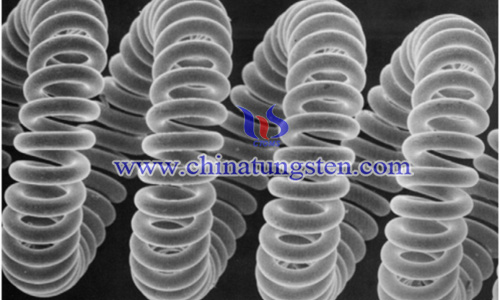100 Years of Doped Tungsten Wire Ⅲ - The Invention of Hard Metals
- Details
- Category: Tungsten Information
- Published on Wednesday, 13 July 2022 19:17
The Invention of Hard Metals
The next important milestone in the chronology of the development of doped tungsten wires is 1923, which marked the year when K. Schröter, chief engineer of the OSRAM research group in Berlin, Germany, made a cemented carbide or hard metal by combining tungsten carbide (WC) and cobalt powder through mixing, pressing and liquid-phase sintering.
The corresponding patent was filed on March 30, 1923, and granted on October 30, 1925, Karl Schröter is said to be the sole inventor, but he states that this success was a joint effort of the entire research team, which was led by Franz Skaupy during this period. At the same time, H. Baumhauer developed a technique for producing dies for drawing wire in another OSRAM division, the wire division in Berlin-Charlottenburg, for internal use, namely the infiltration of sintered tungsten carbide skeletons with iron. However, the infiltration process was not commercially exploited as it was replaced by a better process for the manufacture of carbide or hard metals using liquid phase sintering of tungsten carbide and cobalt powder.

Fig. 10. PM processing steps of tungsten (Courtesy of E. Kimmel, Towanda, PA.)
Initially, OSRAM's goal was to find a hard alternative material for the rough steel and expensive diamond dies used in the wire drawing process, and this was solved. In 1923, OSRAM's wire drawing division conducted field tests of the new die material, which were so successful that the diamond dies were quickly replaced with 0.3 mm dies, and OSRAM management decided that, due to incompatibilities in the lighting business to sell the license rights. Therefore, at the end of 1925, the patent rights were purchased by Friedrich Krupp AG in Essen, Germany. However, General Electric in the USA also acquired the patent rights for the "Carboloy" brand, which was introduced in 1928.
Back in 1927 at the Leipzig Spring Fair, the new material called WIDIA (for the German word "Wie Diamant" - i.e., like a diamond) began a successstory of worldwide fame. This development would have a revolutionary impact - and not just on tungsten. Today, cemented carbide production is the primary use of tungsten powder. But the hard metal industry also needs more and more of other carbide forming metals such as tantalum, titanium and vanadium. Finally, modern coating technology emerged in the 1960s.

Fig. 11. Tungsten coiled coil
The next new material from the first decade of the tungsten wire development chronology: "heavy metal tungsten", to which iron, nickel, cobalt or copper were added, began production around 1935.
In addition, the second half of the last century saw some remarkable discoveries in the incandescent lighting industry. A major breakthrough in 1959 was the successful application of the first regenerative halogen gas cycle to high-performance incandescent lamps by E. Fridrich and E. G. Zubler. This led to higher requirements for tungsten purity and creep strength of tungsten filaments. Figure 12 shows the redeposition and apparent crystal growth of tungsten within the temperature gradient of the halogen filament ring. As well as the recovery of thoriated tungsten in 1953 and the discovery of rhenium ductility for tungsten and molybdenum in 1956, new and special applications emerged.
The 1960s and 1970s were the beginning of extensive research on the microstructure of doped tungsten, leading to the discovery of potassium-filled bubbles, their formation and evolution, and their effect on recrystallization and high-temperature creep (see next paragraph). Finally, in the 1980s, the requirement for precise control of creep intensity and bulbble distribution was further increased by the successful development of infrared reflective (IR) coatings for halogen lamp bulbs, reflecting the radiated heat back into the filament. To achieve more energy-efficient production meant maintaining the exact position of the coil within the counter-radiation focus, i.e. very high creep intensity, during its lifetime.
(Credit: P. Schade “100years of doped tungsten wire”, International Journal of Refractory Metals and Hard Materials, Volume 28, Issue 6, 2010, Pages 648-660, ISSN 0263-4368)
- Tungsten Manufacturer & Supplier, Chinatungsten Online: www.chinatungsten.com
- Tungsten News & Prices of China Tungsten Industry Association: www.ctia.com.cn
- Molybdenum News & Price: news.molybdenum.com.cn
- Tel.: 86 592 5129696; Fax: 86 592 5129797; Email: sales@chinatungsten.com



 sales@chinatungsten.com
sales@chinatungsten.com